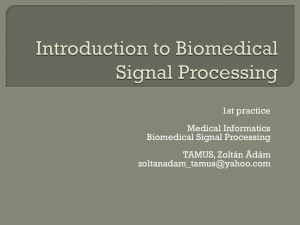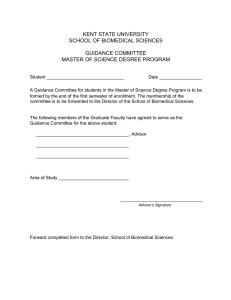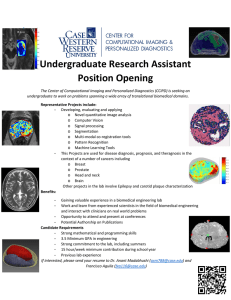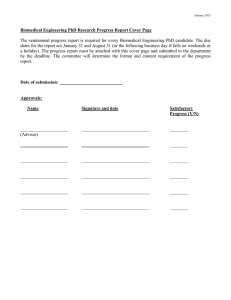MEDICAL SCIENCES - Physiological Measurement
advertisement
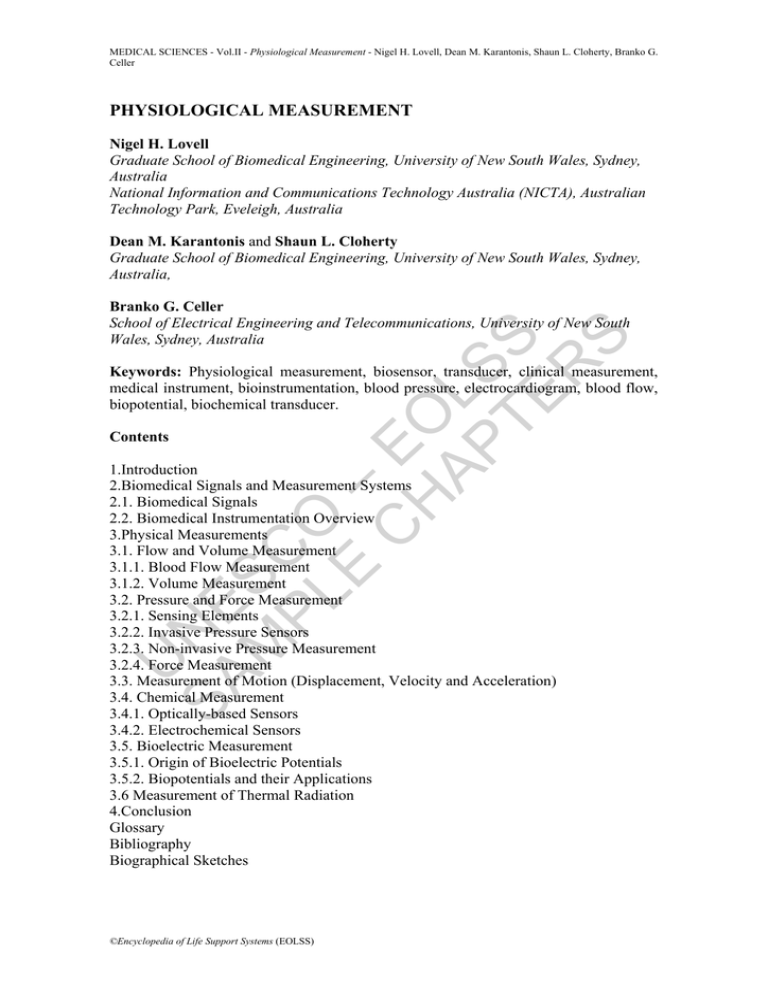
MEDICAL SCIENCES - Vol.II - Physiological Measurement - Nigel H. Lovell, Dean M. Karantonis, Shaun L. Cloherty, Branko G. Celler PHYSIOLOGICAL MEASUREMENT Nigel H. Lovell Graduate School of Biomedical Engineering, University of New South Wales, Sydney, Australia National Information and Communications Technology Australia (NICTA), Australian Technology Park, Eveleigh, Australia Dean M. Karantonis and Shaun L. Cloherty Graduate School of Biomedical Engineering, University of New South Wales, Sydney, Australia, U SA NE M SC PL O E – C EO H AP LS TE S R S Branko G. Celler School of Electrical Engineering and Telecommunications, University of New South Wales, Sydney, Australia Keywords: Physiological measurement, biosensor, transducer, clinical measurement, medical instrument, bioinstrumentation, blood pressure, electrocardiogram, blood flow, biopotential, biochemical transducer. Contents 1.Introduction 2.Biomedical Signals and Measurement Systems 2.1. Biomedical Signals 2.2. Biomedical Instrumentation Overview 3.Physical Measurements 3.1. Flow and Volume Measurement 3.1.1. Blood Flow Measurement 3.1.2. Volume Measurement 3.2. Pressure and Force Measurement 3.2.1. Sensing Elements 3.2.2. Invasive Pressure Sensors 3.2.3. Non-invasive Pressure Measurement 3.2.4. Force Measurement 3.3. Measurement of Motion (Displacement, Velocity and Acceleration) 3.4. Chemical Measurement 3.4.1. Optically-based Sensors 3.4.2. Electrochemical Sensors 3.5. Bioelectric Measurement 3.5.1. Origin of Bioelectric Potentials 3.5.2. Biopotentials and their Applications 3.6 Measurement of Thermal Radiation 4.Conclusion Glossary Bibliography Biographical Sketches ©Encyclopedia of Life Support Systems (EOLSS) MEDICAL SCIENCES - Vol.II - Physiological Measurement - Nigel H. Lovell, Dean M. Karantonis, Shaun L. Cloherty, Branko G. Celler Summary Physiological measurement involves using biosensors, transducers and associated bioinstrumentation to investigate and record various signals from the human body. The focus of this chapter is on the range of physical quantities (typically chemical, mechanical or electrical) that can be sensed or transduced from living organisms and how these physical quantities relate to physiological phenomena. A generalized medical instrument for acquiring physiological measurements is examined with a discussion of the various functional units of transduction, amplification, filtering, digitization and computer processing, analysis, storage and display. U SA NE M SC PL O E – C EO H AP LS TE S R S The various object quantities that can be recorded (flow, volume, pressure, force, motion, chemical and bioelectric events), their physiological correlates and the collection of sensors, which can be used to transduce these signals are presented. Brief descriptions are also offered on how recorded signals can be practically acquired from various organ (principally the circulatory, respiratory, muscular and nervous) systems and used to assist clinical diagnosis and disease management. 1. Introduction Concomitant with the development of modern medicine has been the increasing application of scientific methods and devices in the clinical setting. The central component of the scientific method is measurement. It is therefore not surprising that biological instrumentation and physiological monitoring is an international, multibillion dollar industry. When one needs to understand or manage a system or process, one of the critical requirements is to be able to measure or sample various aspects of the system. From an engineering viewpoint, accurate measurement and acquisition of system observers is a fundamental necessity in order to model, understand and ultimately control a system. From a clinical viewpoint, the basis of a diagnosis is derived from observations and measurements. Physiological measurement or clinical measurement is an integral component of modern clinical medicine, bioscience discovery and medical research. The acquisition or transduction of physiological signs or variables is an essential component of the majority of diagnostic and therapeutic medical devices. In this chapter, we explore the complexity of physiological measurement. Initially a systems approach is taken to examine in a general way a computer-based, clinical recording instrument. A ‘black box’ representation of the instrument is presented – where we consider the instrument as a collection of functional units. This representation is broken down or reduced to functional units including transduction, amplification, filtering, digitization and computer analysis. Each unit is described in detail. The majority of the chapter however focuses on the very first unit in the instrument, namely that of biosensing. In a biosensor, a physical quantity that has a correspondence with a physiological variable is sensed and typically converted or ‘transduced’ to an electrical quantity for further processing by the instrument. In terms of terminology, a transducer is the general name for a sensor or actuator. In a broad definition, a sensor is ©Encyclopedia of Life Support Systems (EOLSS) MEDICAL SCIENCES - Vol.II - Physiological Measurement - Nigel H. Lovell, Dean M. Karantonis, Shaun L. Cloherty, Branko G. Celler a device that detects a change in physical stimulus and converts it into a signal, which can then be measured or recorded. An actuator does the converse in that it produces observable outputs in a system. The general concept of ‘transduction’ therefore is a device that transfers a signal from one energy system to another in the same or in a different form. In the majority of cases, a sensor converts a measured object quantity into an electrical signal. Once an object quantity is converted into an electrical signal, then standard instrumentation techniques can be applied. The other term which needs definition is that of ‘signal’. The essential characteristic of a signal is that of being able to change as a function of space or time. In the case of a biological signal, it is a detectable unit of information that characterizes the behavior, structure or function of the biological system or process under study. U SA NE M SC PL O E – C EO H AP LS TE S R S It is useful to associate the type of signal with various forms of energy. Table 1 lists different forms of energy and corresponding examples of the signal types that may be measured from these sources. When performing physiological measurement, some signals are intrinsic to bodily function (for example voltages from biopotentials), whereas others are modulated when external energy sources are applied to the body (for example, blood flow in a vessel measured using an electromagnetic or ultrasonic flow meter). This chapter is primarily arranged in sequence of the various object quantities being measured, their physiological correlates and the collection of sensors, which can be used to transduce these signals. Object quantities in biomedical measurements are typically chemical, mechanical or electric quantities that echo physiological functions in the living system. The other way to present physiological measurement information would be based on the organ system in which the measurement was being made. Instead of employing this approach, we shall highlight how a number of measurement techniques can be applied and adapted to organ systems as the various signal types are described. Measurements are routinely made on all the organ systems in the body, although the first four systems in the following list are the ones in which most physiological measurements are made, and are thus the focus of this chapter. Circulatory System: Comprises the heart, blood, blood vessels, and lymphatics. It is concerned with circulating blood to deliver oxygen and nutrients to every part of the body. Nervous System: Is made up of the brain, spinal cord, and central and peripheral nerves. It receives and interprets stimuli from sensory organs and transmits impulses to effector organs. Musculoskeletal System: Consists of muscles, bones, cartilage, ligaments, tendons and joints. It comprises muscle tissue that helps move the body and move materials through the body. It provides the shape and form for our bodies in addition to supporting and protecting our bodies, allowing bodily movement and producing blood cells. Respiratory System: It consists of the nose, larynx, trachea, diaphragm, bronchi, and lungs. The principal function of the respiratory system is to supply the blood with oxygen for delivery to the tissues. Digestive System: The organs involved in this system include the mouth, stomach, ©Encyclopedia of Life Support Systems (EOLSS) MEDICAL SCIENCES - Vol.II - Physiological Measurement - Nigel H. Lovell, Dean M. Karantonis, Shaun L. Cloherty, Branko G. Celler gall bladder and intestines. Endocrine System: This system is made up of a collection of glands, including the pancreas, adrenal pituitary and thyroid, as well as the ovaries and testes. It regulates, coordinates, and controls a number of body functions by secreting hormones and neurotransmitters into the bloodstream. Integumentary System: This system consists of the skin, hair, nails, and sweat glands. Its main function is to act as a barrier to protect the body. Reproductive System: It comprises organs such as the uterus, penis, ovaries, and testes. Urinary System: It consists of the kidneys, ureters, urinary bladder, and urethra. U SA NE M SC PL O E – C EO H AP LS TE S R S It should be noted that a single chapter cannot examine all aspects of physiological measurement, nor for that matter even one aspect in detail. Indeed not just books but entire encyclopedic volumes have been dedicated to or have been strongly focused on such treatises. The focus of this chapter will be to document the range of physical quantities which these devices encompass without resorting to complex formulae or detailed technical aspects of the underlying sensing technology. Energy Source (Object Quantities) Example Signals Mechanical force, pressure, flow, acceleration, velocity, displacement Electrical voltage, current, inductance Molecular/Atomic (Chemical) chemical composition, pH value Thermal temperature Radiant visible light, infrared, radio waves Magnetic magnetic flux resistance, capacitance, Table 1. A list of energy sources and common signals measured from these sources. 2. Biomedical Signals and Measurement Systems 2.1. Biomedical Signals The collection of physiological data is basically the process of scientific observation and may be performed without instrumentation. However instrumentation can be used to amplify, highlight, detect, retain, archive, automate and further process observations beyond that possible by a human operator. There are many issues associated with ©Encyclopedia of Life Support Systems (EOLSS) MEDICAL SCIENCES - Vol.II - Physiological Measurement - Nigel H. Lovell, Dean M. Karantonis, Shaun L. Cloherty, Branko G. Celler performing a physiological measurement on biological tissue. Put simply, they are difficult measurements to take because of signal artifact and noise from myriad sources and because of issues related to the influence of the measuring device on the underlying biological function. Moreover, it is most common that the health care worker will need to decide which particular signal out of a range of signals is most appropriate in order to measure the behavior of the living system. For example, in measuring the activity of the heart it is possible to measure signals related to pressure, flow, motion, volume, bioelectricity and/or biochemistry. U SA NE M SC PL O E – C EO H AP LS TE S R S Each signal will necessarily describe a different aspect of cardiac activity or function/dysfunction. It is actually necessary to record multiple signals to gain a more complete picture of cardiac function. To derive an index of ventricular contractility (the amount of work the heart is capable of doing), it is necessary to record both ventricular pressure and ventricular volume over the course of time. To derive information on conduction abnormalities in the heart (arrhythmias), an electrical measurement technique known as an electrocardiograph (ECG) would be most appropriate. In this noninvasive technique, multiple electrodes are attached to the body surface to infer the conduction behavior of the heart. In circumstances where the cardiac arrhythmia is potentially life-threatening a more complete cardiac mapping study may be undertaken whereby, electrodes are introduced inside the heart to record directly the cardiac electrical activity. In a separate approach, biochemical analysis of the blood would be the most useful approach for detecting the incidence and severity of a recent myocardial infarction (death of heart tissue leading to a heart attack).Part of the evolving nature of biomedical engineering research and development is the discovery of new sensing technologies and associated instruments. Studies would then need to be undertaken to match the properties of the instrumentation with those of the biological signal. In an iterative process as the research and clinical trials progressed, measurement techniques and technologies would be further refined as more of the signal characteristics were understood. As these techniques then became clinically validated and more widely accepted, they would migrate from research laboratories to be used in everyday clinical practice. Naturally, at this stage the economic implications of such technology in terms of costbenefit and improved patient health outcomes would also need to be evaluated as part of the rationale to routinely use such equipment. History serves an example. It was not until the end of the 19th century that bioelectric signals were able to be recorded as part of cardiac activity monitoring. Prior to this, cardiac activity was only able to be characterized by pressure and flow signals and these signals failed to reveal the complex underlying electrical activity of the heart, the genesis of cardiac rhythm and the multiplicity of rhythm disturbances (arrhythmogenesis). As more sophisticated signal processing techniques as well as instrument designs were introduced in the 1960s and 1970s, cardiac activity monitoring via bioelectric phenomenon was even able to localize probable areas of myocardial infarction as well as other major heart diseases/pathologies. ©Encyclopedia of Life Support Systems (EOLSS) MEDICAL SCIENCES - Vol.II - Physiological Measurement - Nigel H. Lovell, Dean M. Karantonis, Shaun L. Cloherty, Branko G. Celler - TO ACCESS ALL THE 49 PAGES OF THIS CHAPTER, Visit: http://www.eolss.net/Eolss-sampleAllChapter.aspx Bibliography U SA NE M SC PL O E – C EO H AP LS TE S R S Anderson IA and Lim K, (2006) Force Measurement, in Wiley Encyclopedia of Biomedical Engineering, John Wiley and Sons. [This chapter provides an assessment of force measurement in relation to gait analysis and muscle strength]. Bronzino JD (2006) The Biomedical Engineering Handbook. 3rd Edition. CRC Press. [This book provides a review of flow, pressure and other types of physiological monitoring]. Brown M, Marmor M,Vaegan, Zrenner E, Brigell M, and Bach M, (2006) ISCEV Standard for Clinical Electro-oculography (EOG), Doc. Ophthalmol., 2006;113:205-212. [International Society for Clinical Electrophysiology of Vision (ISCEV) standard for clinical application of the EOG including a description of basic protocols, practical aspects and technical procedures]. Fontaine AA, Manning KB and Deutsch S, (2006) Flow Measurement, in Wiley Encyclopedia of Biomedical Engineering, John Wiley and Sons. [A summary of several liquid flow measuring methods is provided in this chapter]. Geddes LA and Baker LE (1975) Principles of Applied Biomedical Instrumentation, 3rd ed., John Wiley & Sons. [Information regarding respiratory gas analysis and basic information on the electrode-tissue information was sourced from this book]. Karamanoglu M and Feneley MP, (1997) On-line synthesis of the human ascending aortic pressure pulse from the finger pulse. Hypertension ; 30:1416-1424. [This study describes how we can ascertain the aortic blood pressure waveform by recording the finger cuff pressure]. Marmor MF, Holder GE, Seeliger MW and Yamamoto S, (2004) Standard for Clinical Electroretinography (2004 Update), Doc. Ophthalmol., 108:107-114. [International Society for Clinical Electrophysiology of Vision (ISCEV) standard for clinical application of the full-field ERG including a description of basic technical procedures. This paper also includes useful references which describe the measurement of other specialized ERGs]. Masood S and Yang G-Z, (2006) Blood Flow Measurement, in Wiley Encyclopedia of Biomedical Engineering, John Wiley and Sons. [A description of techniques based on magnetic resonance for blood flow measurement is given here]. Mootanah R and Bader DL, (2006) Pressure Sensors, in Wiley Encyclopedia of Biomedical Engineering, John Wiley and Sons. [An overview of the electrical transducers and their application in pressure measurement is provided in this chapter]. Posey JA, Geddes LA, Williams H and Moore AG, (1969) The meaning of the point of maximum oscillations in cuff pressure in the indirect measurement of blood pressure, Part 1, Cardiovasc Res Cent Bull;8:15. [This study demonstrates the correlation between mean arterial pressure and the point of maximum amplitude obtained in cuff pressure oscillations]. Ramsey M, (1979) Noninvasive automatic determination of mean arterial pressure, Med Biol Eng Comput.;17:11. [This study demonstrates the method by which mean arterial pressure may be obtained non-invasively]. Togawa T, Tamura T and Oberg PA (1997) Biomedical transducers and instruments. CRC Press, Florida, USA. [This book provides an in depth assessment of many biomedical instruments, particularly those ©Encyclopedia of Life Support Systems (EOLSS) MEDICAL SCIENCES - Vol.II - Physiological Measurement - Nigel H. Lovell, Dean M. Karantonis, Shaun L. Cloherty, Branko G. Celler associated with flow, pressure, force, and motion measurements]. Webster J (1998) Medical Instrumentation: Application and Design, 3rd edition, John Wiley & Sons, New York. [A frequently used textbook for biomedical engineering instrumentation course, it describes many aspects of transducer design and measurement]. Weyman AE (1994) Principles and Practice of Echocardiography, 2nd ed., Lea & Febiger Publishers, Philadelphia, PA. [This book provides a detailed view of the principles underlying ultrasonic flow meters]. Wilkinson I and Webb D, (2001) Venous occlusion plethysmography in cardiovascular research: methodology and clinical applications. Br J Clin Pharmacol. ;52:631-646. [This paper describes the application of the venous occlusion plethysmography technique for assessing changes in physiological volumes]. Biographical Sketches U SA NE M SC PL O E – C EO H AP LS TE S R S Nigel Lovell received the BE (Hons) and PhD degrees from the University of New South Wales (UNSW), Sydney, Australia. He is currently a Professor in the Graduate School of Biomedical Engineering. Prof Lovell's research work has covered areas of expertise ranging from cardiac modeling, home telecare technologies, biological signal processing and visual prosthesis design, having authored over 250 refereed journals, conference proceedings, book chapters and patents. He is a board member of the journal 'Physiological Measurement', a founding board member of the 'Journal of Neural Engineering' and an Associate Editor of 'Transactions on Information Technology in Biomedicine'. He has been awarded over $25 million in research, consultancy and infrastructure funding in his career. He has successfully led the bid to hold the World Congress in Biomedical Engineering and Medical Physics in Sydney in 2003, being the conference co-chair for this major international triennial event. In 2007 he co-chaired the Scientific Program Committee for the 29th Annual International Conference of the IEEE Engineering in Medicine and Biology Society in Lyon, France. Dean Karantonis graduated with the BE (Hons) degree in computer engineering and the MBiomedE degree in biomedical engineering from the University of New South Wales (UNSW), Sydney, Australia, in 2005. At present he is undertaking a PhD degree with the Graduate School of Biomedical Engineering at UNSW in collaboration with industry partner Ventracor, with the research focused on simulation and control of an implantable rotary blood pump. Shaun L. Cloherty received the B.E. (Hons) degree in aerospace avionics from the Queensland University of Technology, Brisbane, Australia, in 1997. He received the Ph.D. degree in biomedical engineering from the University of New South Wales, Sydney, Australia, in 2005. He is currently a Research Associate with the Graduate School of Biomedical Engineering at the University of New South Wales, Sydney, Australia. His current research interests include cardiac electrophysiology and modeling, flow estimation and modeling for control of an implantable rotary blood pump, and modeling of electrical stimulation strategies for selective excitation of neural tissue for a visual prosthesis. Professor Branko Celler is Director of the Laboratory for Health Telematics and CEO of TeleMedCare Pty Ltd. He was the Head of the School of Electrical Engineering and Telecommunications at the University of NSW in Sydney Australia from 1998-2005. He is internationally recognized for his pioneering work on home telecare. His research interests include health care telematics, biomedical instrumentation, signal processing and medical expert systems. Over the last 10 years he has been actively involved in R&D on the application of information and communications technology in primary health care and he has a particular interest in managing chronic disease and the remote monitoring of health status of the elderly at home. He is a Foundation Member of the Australian College of Medical Informatics and was the Foundation Co-Director of the Centre for Health Informatics at the University of New South Wales. ©Encyclopedia of Life Support Systems (EOLSS)
